Perth Corporation Tramways
History
Perth Corporation acquired the assets of the local 3ft 6ins-gauge horse tramway — the Perth and District Tramways Company — on the 7th October 1903, the company working the system for a further 5 days before the corporation took over operation itself on the 12th October. The horse trams continued to run for just over two years, as the corporation went about the process of conversion to electric traction; the last horse tram ran on the 31st October 1905, with electric cars taking over at 2.00pm the same day.
Unfortunately, the municipal enterprise was hamstrung by a series of poor decisions, both on the part of the corporation, and also, the consulting engineers they had appointed to oversee matters, Kincaid, Waller, Manville and Dawson of Westminster. Among the more curious decisions, was the siting of the main depot at the extremity of the system (in Scone) rather than the centre, which inevitably resulted in significant unremunerative mileage getting the trams to and from the depot. The main bone of contention however, was the low ceiling height of the tramcar interiors, which had been built — on the instruction of KWMD, and without the approval of the corporation — to a height of just under 6ft 1½ins, rather than the expected 6ft 6ins (on account of a low railway bridge). The corporation took great exception to this, and ultimately, insisted on the ceilings of the cars being raised, a move which weakened the structure, and therefore, longevity of the vehicles.
Although the tramway was able to cover its costs — operationally — it could never hope to service the debt incurred in purchasing the horse tramway, reconstructing the system and equipping it. It was after all a rather small system, so the level of debt and the inevitable call on the ratepayes, was something that would have consequences throughout the system's life, partcularly when it came to investment.
The system emerged from the Great War, like many others, in poor condition, and in need of signiificant expenditure. After struggling on through the 1920s, matters came to a head in February 1927 in the form of a report by R Stuart Pilcher of Edinburgh Corporation Transport, who strongly recommended abandoning the tramway in favour of buses. Fortunately, the corporation already had extensive experience of bus operation (since 1911 in fact), and they lost no time in procuring additional buses to replace the trams. They were however constrained by the 1908 legislation that governed their bus services, which limited the corporation to operating only within three miles of a tram route, so they were forced to continue running the trams until new powers had been obtained. This led to the unusual situation of corporation buses running over the same routes as the corporation tramcars, though the latter were greatly reduced in number and frequency, and often ran empty. Powers to operate the buses with greater freedom, and to abandon the tramway were eventually granted, with the final tramcar running on the 19th January 1929.
Uniforms
Following its takeover of the erstwhile Perth and District Tramways Company in 1903, the corporation appears to have quickly got down to the business of stamping its municipal identity on the enterprise. A record has survived (in Perth Archives) which shows that the corporation purchased the following — in November 1903 — from C & J Weldon of London: 24 'Conductor' badges at 1s 3d each, 24 'Driver' badges at 1s 0d each, 24 metal badges — 'PCT' — at 1s 6d each, and 18 assorted numbers at 6s 0d total (I am indebted to Alan Brotchie for this information). A pay list has also survived for the week ending 7th November 1903 (actually drawn up on an old P&DTCo form), and this reveals that in addition to clerical and depot staff, the corporation at this time employed 8 drivers (plus one spare); 8 conductors (plus one spare), and perhaps surprisingly for such a small enterprise, 2 inspectors.
Uniforms were presumably ordered at the same time, and these took the form of single-breasted jackets with five buttons, two breast pockets (with triangular button-closed flaps) and lapels; other than the buttons, which contained the full system title around the municipal device (see link), the jackets were completely devoid of insignia. Caps were soft-topped with a glossy peak and carried script-lettering grade badges — either Driver or Conductor — above which an employee number was worn. The employee number was rather elaborate, comprising the number within a circular border; whether the border bore the system title or was just plain, is currently unknown. It would appear that the same number was issued to both a conductor and a driver, so strictly speaking they were not employee numbers but grade numbers. The cap badges were presumably nickel to match the buttons. Horsecar crews were also issued with heavy-duty, double-breasted greatcoats with two rows of five buttons and high, fold-over collars; the bearer's right-hand collar bore system initials — 'P C T' — in individual nickel letters, along with an employee number.
The uniform remained unchanged following electrification, though it would appear that only the initial horse tram employees were issued with the employee/grade numbers, as these are seldom seen in photos from this era, suggesting that only the original recipients continued to wear them. At some point prior to the Great War, the soft-topped caps were replaced by a more modern military style of cap with a tensioned crown (top); these continued to carry the standard, 'off-the-shelf' grade badges. Following the Great War, conductors, but not motormen, wore an employee number — in individual metal numerals — above their script-lettering grade cap badges, a practice that as far as I am aware was unique amongst UK tramway operators. Around the same time, the Driver cap badges were superseded by script-lettering Motorman badges.
Inspectors wore single-breasted jackets with lapels; it is unclear whether the latter carried any insignia. In later years, caps were in a military style with a tensioned crown, and carried a hat band bearing the grade — Inspector — in embroidered script lettering. Inspectors were also issued with double-breasted overcoats with two rows of plain black buttons and lapels; the overcoats bore no insignia whatsoever.
In common with the vast majority of UK tramway systems, Perth employed the services of female conductresses during the Great War to replace men lost to the armed services, though not until the relatively late date of summer 1918, when eight ladies were taken on. These ladies were issued with tailored single-breasted jackets with five buttons, two breast pockets (with button closures) and lapels, along with a long matching skirt; the entire ensemble was devoid of insignia. Baggy caps were worn that were probably intended to bear the standard Conductor grade badge, though these were frequently replaced by regimental sweetheart badges, a common practice during the war to show solidarity with a loved one on active service.
Further reading
For a full history of Perth Corporation Tramways, see: 'Perth's Trams and Early Buses' by Alan W Brotchie; Stenlake Publishing Limited (2019).
Images
Horse tram drivers and conductors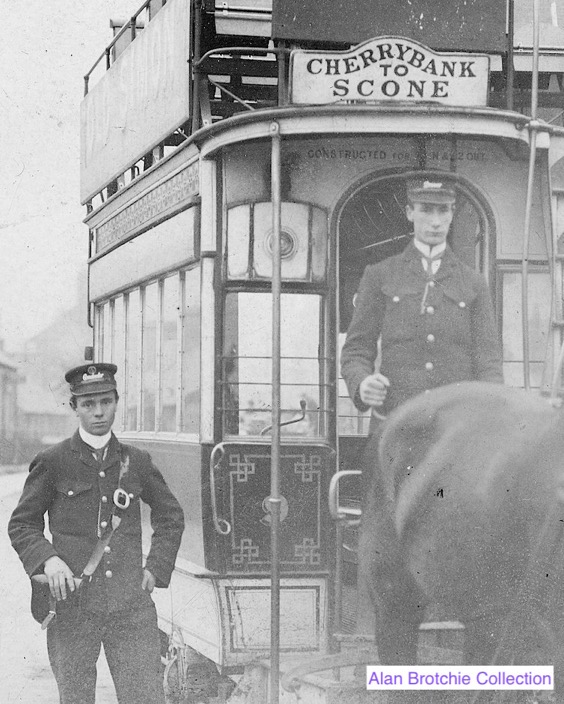
PCT Horsecar No 9 (new in 1903), at the Cherrybank terminus, with conductor and driver both in single-breasted jackets — photo undated, but judging by the pristine condition of the uniforms, probably taken in early 1904.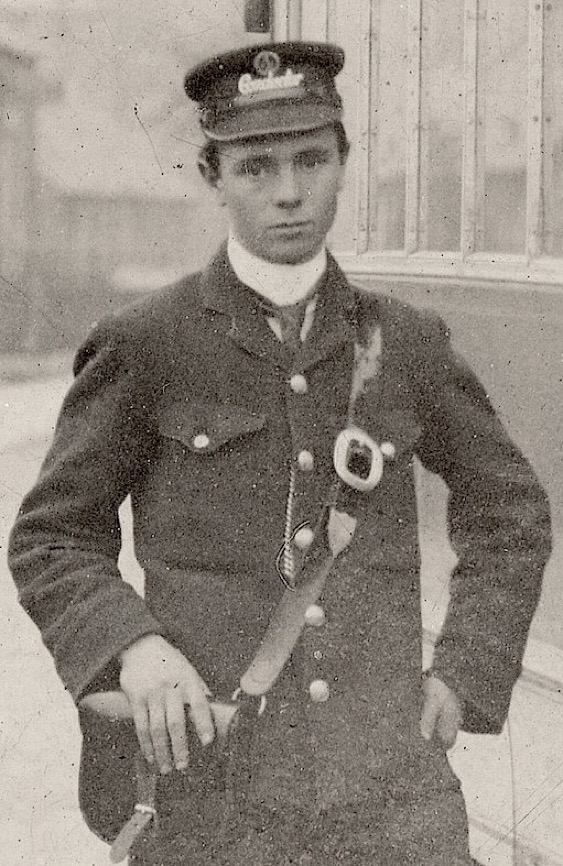
A blow-up of the above photograph showing the conductor — No 4. Other than the buttons, the jacket is completely devoid of insignia. The cap is soft-topped and bears a script-lettering Conductor cap badge, along with an employee number — '4' — within a circular border. The uniform and cash bag, etc., appear to be brand new.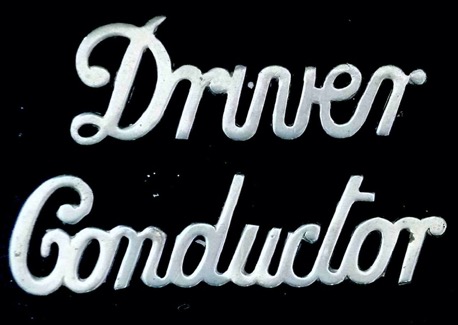
Standard, 'off-the-shelf', script-lettering grade badges of the type used by Perth Corporation Tramways — nickel. Author's Collection.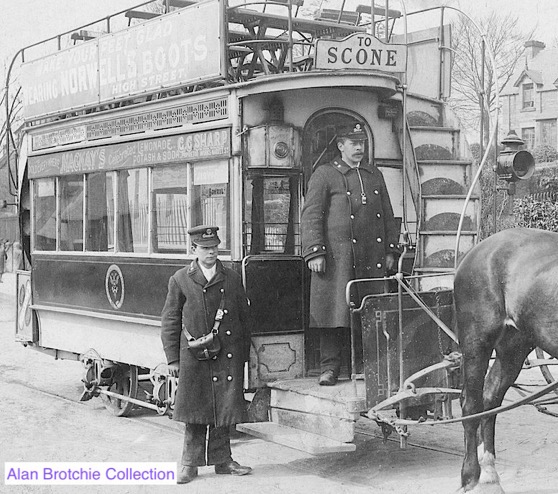
Horsecar No 1 under corporation ownership at the Cherrybank terminus — photo undated, but probably taken in 1904.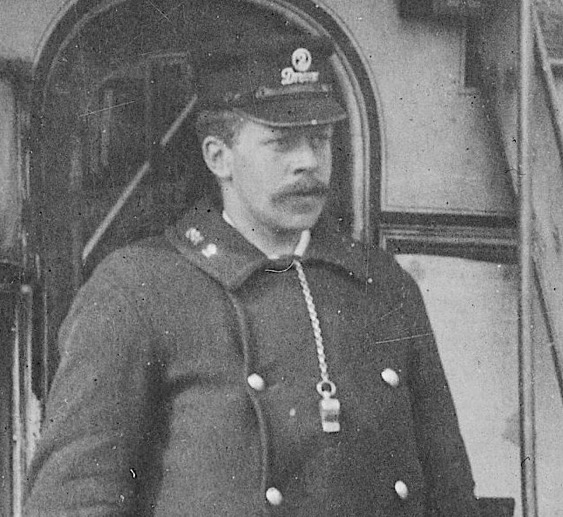
A blow-up of the above photograph showing Driver John Bruce, who had previously worked for Perth and District Tramways Company (see link). The collar initials appear to be 'P C T' along with a number '2'. The cap bears a standard script-lettering grade badge — Driver — above which appears to be an employee number badge, again a '2', but within a circular border. It may just be coincidence, but John Bruce was the second driver in the PCT's pay list of November 1903 (see above), so the latter may be in employee order.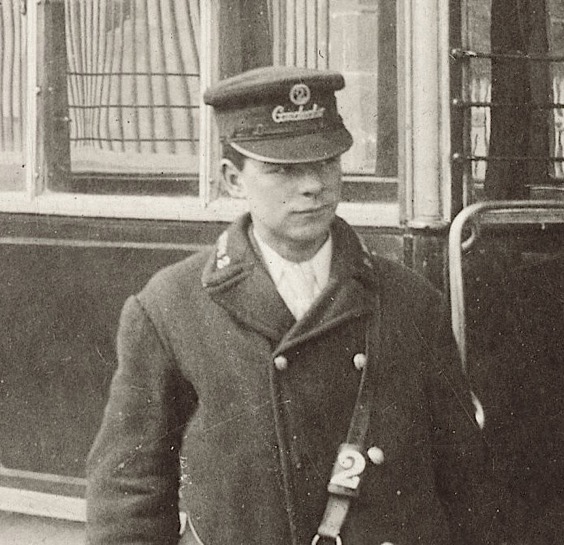
Another blow-up of the above photograph, this time showing Conductor George (Tripey) Buchanan. Curiously, his uniform bears the same employee number ('2') as John Bruce, suggesting that the same number was given to both a driver and a conductor, making it more a grade number than an employee number. George carries the number on his cap and greatcoat collar, as well as on his cash-bag strap. He does not appear on the 1903 pay list, suggesting that this photo may have been taken in late 1904 or even 1905.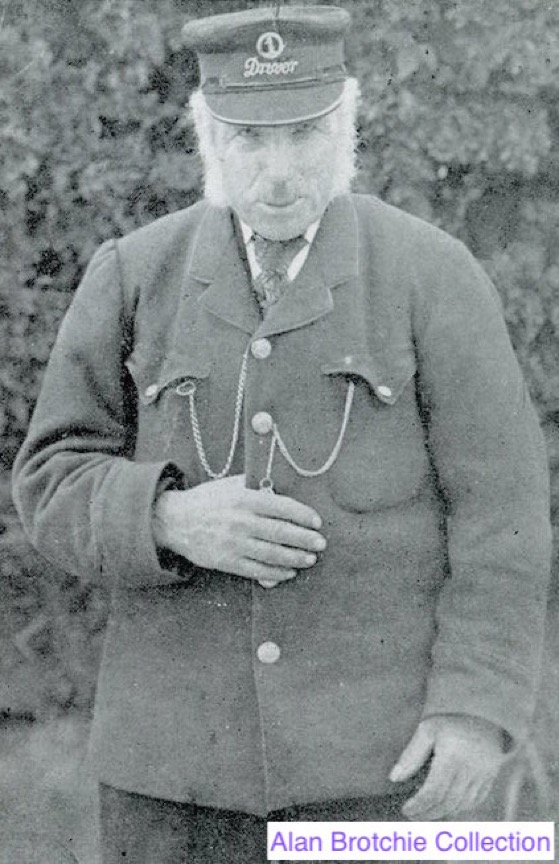
PCT Driver No 1 — James 'Jeems' Robertson — by all accounts (and looks) a bit of a character, given that this picture appeared in the Evening Post. He is also the first driver in the aforementioned PCT November 1903 pay list.
Motormen and conductors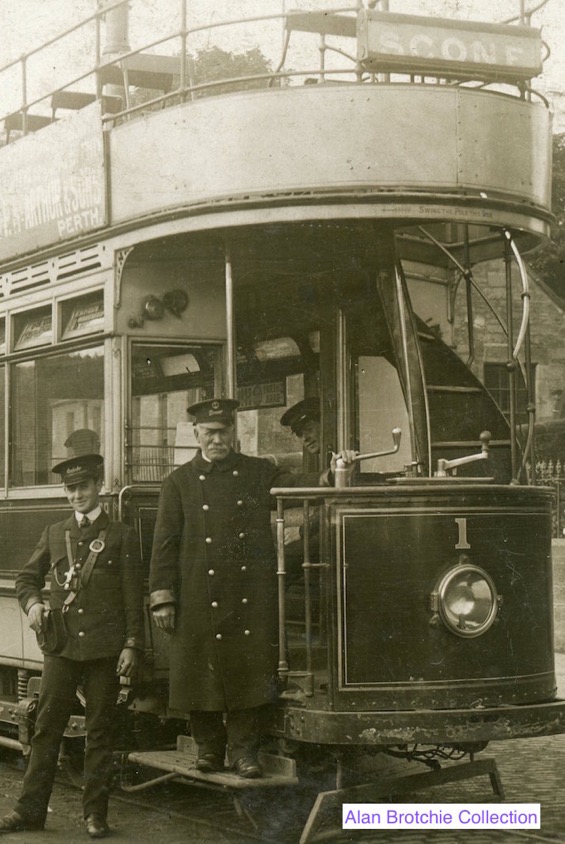
Conductor and motorman (called 'Drivers' in Perth up to the 1920s) with Tramcar No 1 at the Cherrybank terminus — photo undated, but judging by the condition of the tram, possibly taken shortly before the Great War.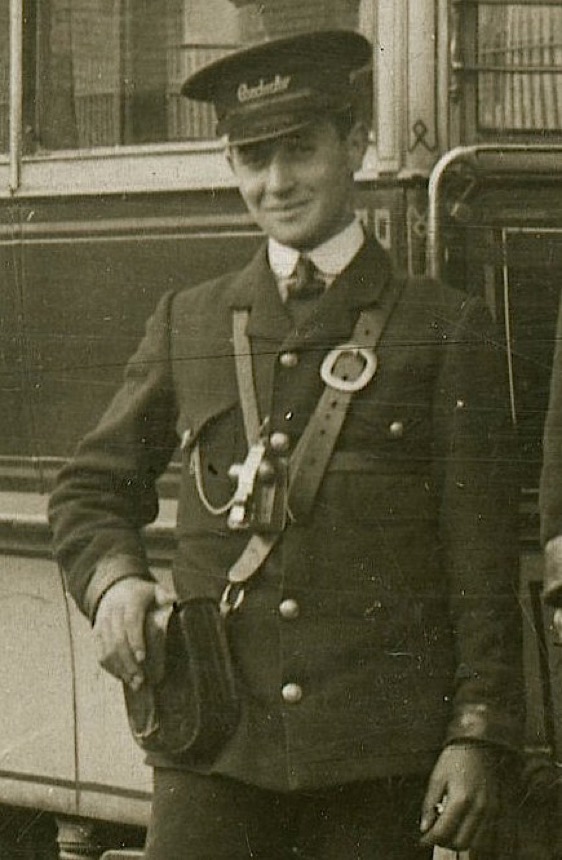
A blow-up of the above photograph showing the conductor. The jacket is identical to those worn by the crews who worked the horse trams; the cap only bears a grade badge, suggesting that the employee number badges may only have been issued to the initial tranche of horse tram staff. The cap is no longer soft-topped, having a more modern tensioned crown (top)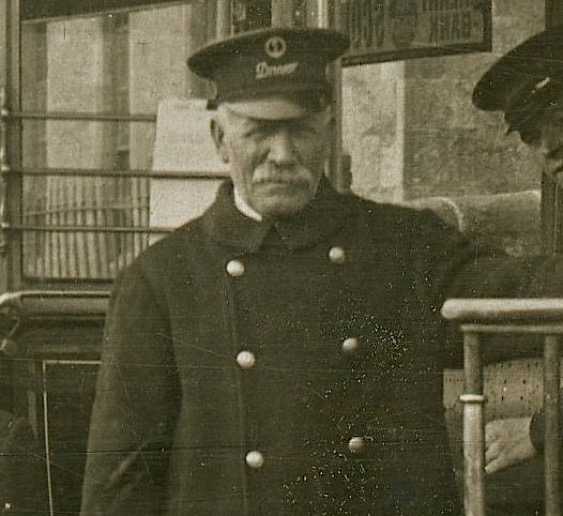
Another blow up of the above photo, this time showing the rather elderly looking motorman. He is wearing an employee number badge, possibly '7'. Other than the buttons, the greatcoat bears no badges or markings of any kind.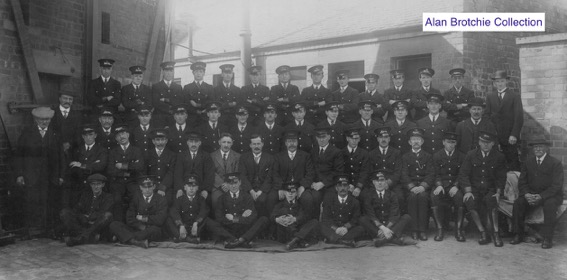
Staff photo taken at the Perth Road depot — photo undated, but probably taken in the mid-to-late 1920s, given that John Bruce - seated centre — is an inspector.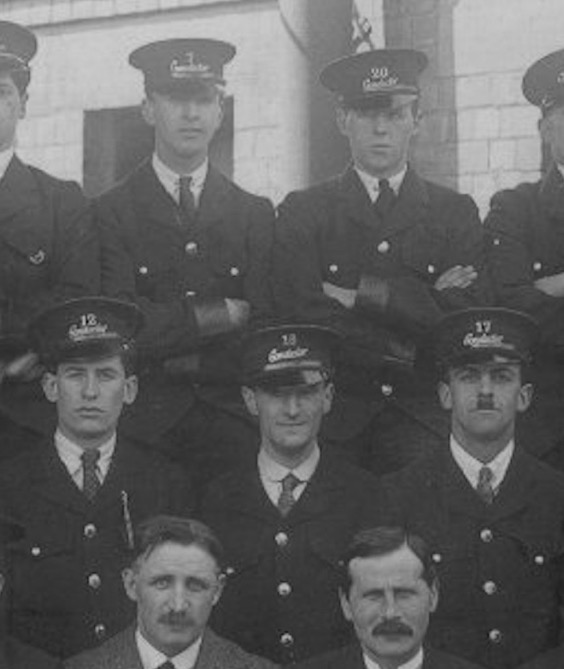
A blow up of the above photo showing a group of conductors, all of whom are wearing employee numbers (in individual numerals) above their grade cap badges. Close examination of the main photo reveals that all the conductors have employee numbers, whereas none of the motormen do.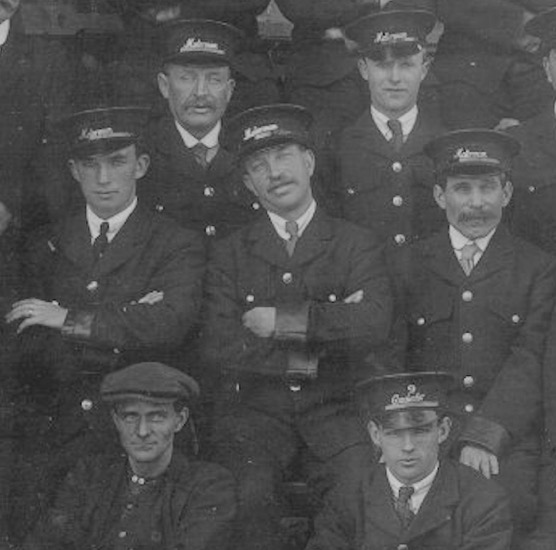
Another blow-up of the above photo showing six of the motormen. By this time, the script-lettering Driver cap badge had been replaced by its Motorman equivalent, possibly because the former was reserved for non-tramway occupations.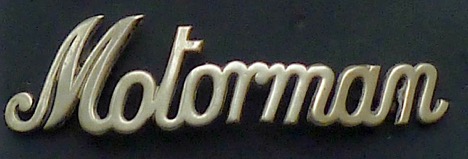
Script-lettering grade badge — Motorman — nickel, of the type issued by Perth Corporation Tramways during the 1920s. Author's Collection.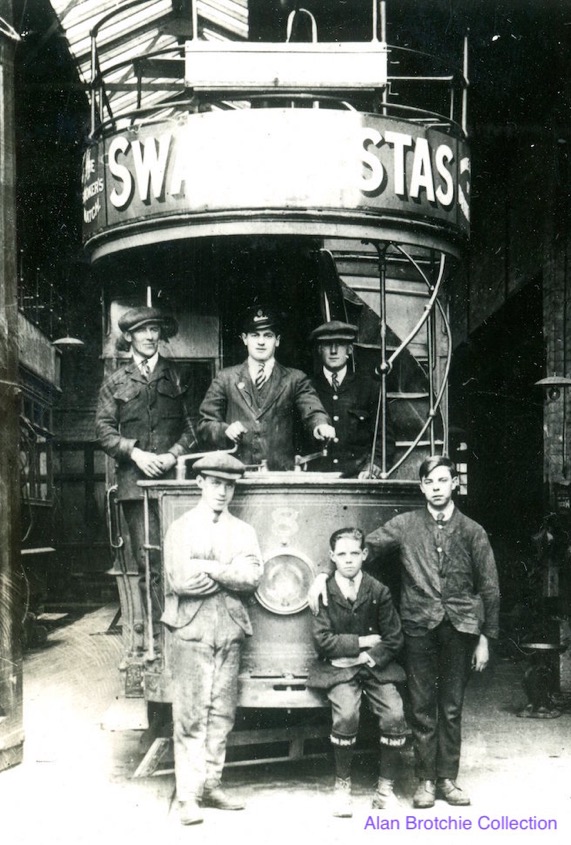
An evocative depot photo showing an array of fitters and workshop staff — photo undated, but probably taken in the 1920s.
Senior staff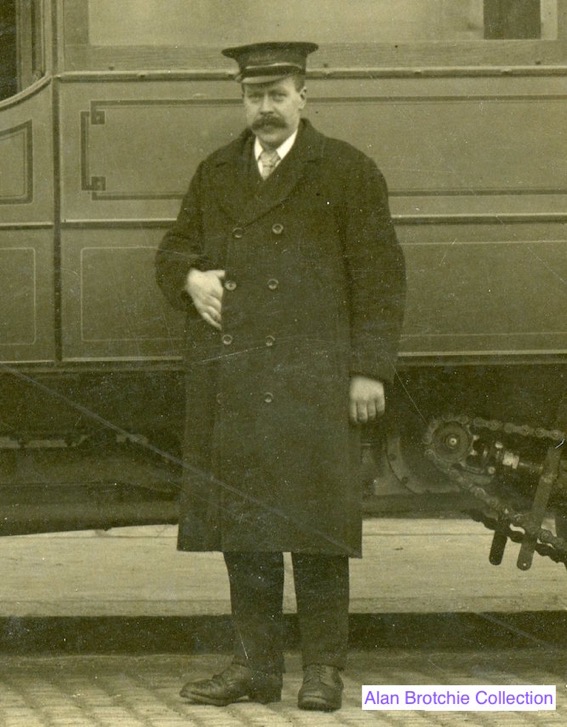
Inspector John Bruce — photo undated, but probably taken in the 1920s. Although he is stood in front of a bus, the Tramways Department initially ran the buses, so inspectors probably spanned the two forms of traction. His cap bears a hat band with his grade — Inspector — in embroidered script lettering.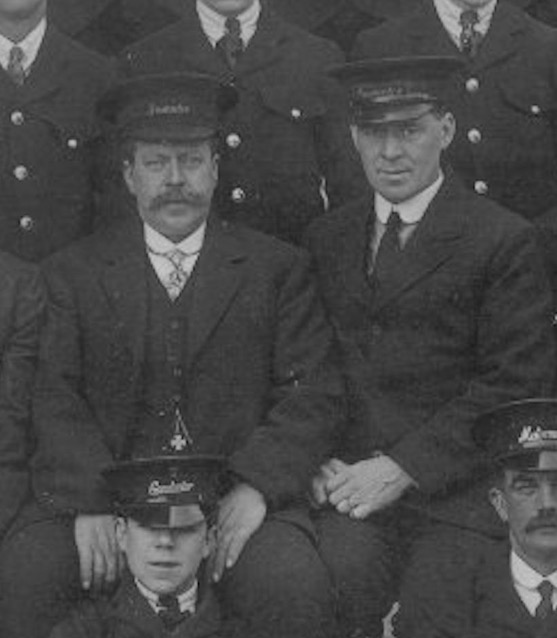
A blow-up of the staff photo above showing Inspector John Bruce (on the left) and another colleague of the same grade; both are wearing single-breasted jackets with lapels.
Female staff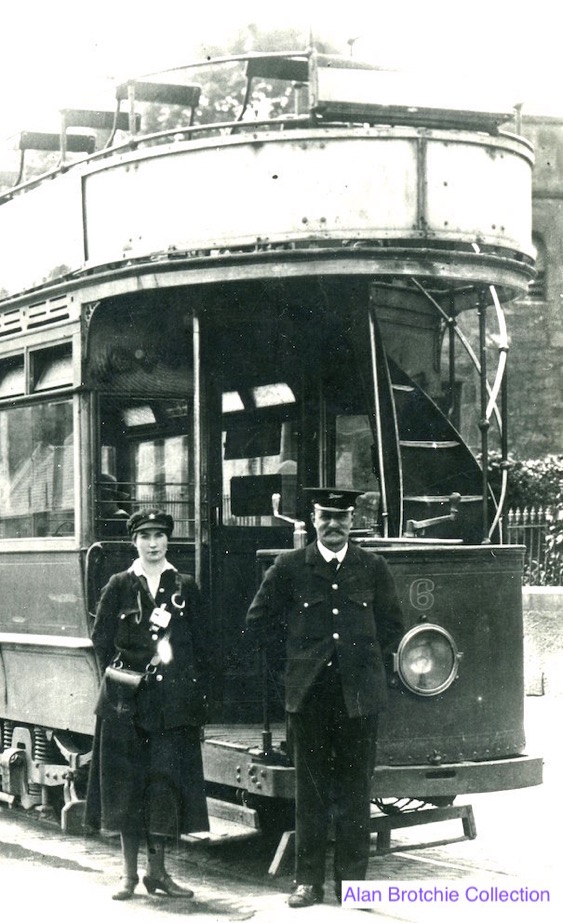
Conductress and motorman (John Bruce) with Tramcar No 6 at Cherrybank terminus — photo undated, but probably taken in 1918.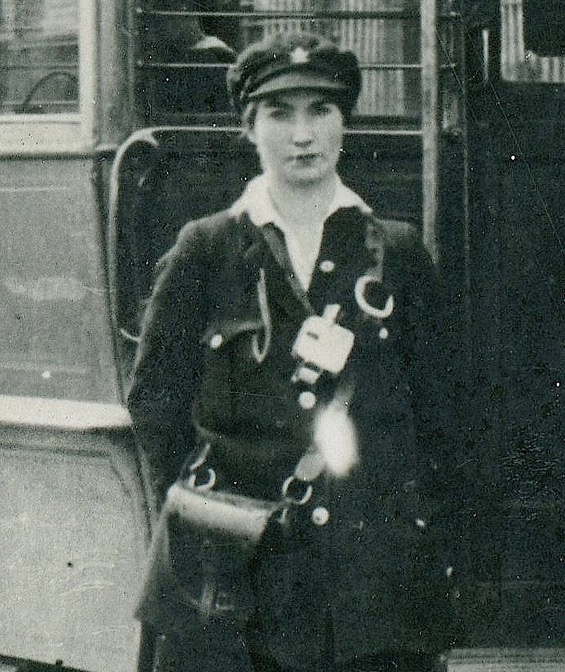
A blow-up of the above photo showing the conductress, who is wearing a tailored jacket, and a baggy cap bearing a military cap badge, a common practice during the Great War.